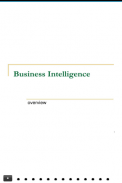






Business Intelligence

Business Intelligence介绍
Business Intelligence (BI) comprises the set of strategies, processes, applications, data, technologies and technical architectures which are used by enterprises to support the collection, data analysis, presentation and dissemination of business information. BI technologies provide historical, current and predictive views of business operations. Common functions of business intelligence technologies include reporting, online analytical processing, analytics, data mining, process mining, complex event processing, business performance management, benchmarking, text mining, predictive analytics and prescriptive analytics. BI technologies can handle large amounts of structured and sometimes unstructured data to help identify, develop and otherwise create new strategic business opportunities. They aim to allow for the easy interpretation of these big data. Identifying new opportunities and implementing an effective strategy based on insights can provide businesses with a competitive market advantage and long-term stability.
Business intelligence can be used by enterprises to support a wide range of business decisions - ranging from operational to strategic. Basic operating decisions include product positioning or pricing. Strategic business decisions involve priorities, goals and directions at the broadest level. In all cases, BI is most effective when it combines data derived from the market in which a company operates (external data) with data from company sources internal to the business such as financial and operations data (internal data). When combined, external and internal data can provide a more complete picture which, in effect, creates an "intelligence" that cannot be derived by any singular set of data. Amongst myriad uses, business intelligence tools empower organizations to gain insight into new markets, to assess demand and suitability of products and services for different market segments and to gauge the impact of marketing efforts.
Components
Business intelligence is made up of an increasing number of components including:
• Multidimensional aggregation and allocation
• Denormalization, tagging and standardization
• Realtime reporting with analytical alert
• A method of interfacing with unstructured data sources
• Group consolidation, budgeting and rolling forecasts
• Statistical inference and probabilistic simulation
• Key performance indicators optimization
• Version control and process management
• Open item management
Download Buisness Intelligence app for FREE now!
DISCLAIMER :
Content like Articles, Pictures and Video in this application were collected from all over the web, so if I have violated your copyright, please let me know and it will be removed as soon as possible.
All copyrights and trademarks are owned by their respective owners. This app is not endorsed by or affiliated with any other affiliated entities.
All images used in this app are believed to be in public domain. If you own rights to any of the images, and do not wish them to appear here, please contact us and they will be removed.
商业智能(BI)包括一系列策略,流程,应用程序,数据,这些企业所使用,支持收集技术和技术架构,数据分析,显示和商业信息的传播。 BI技术提供业务运营的历史,当前和预测的意见。商业智能技术的通用功能包括报告,联机分析处理,数据分析,数据挖掘,过程挖掘,复杂事件处理,企业绩效管理,标杆管理,文本挖掘,预测分析和规范分析。 BI技术能够处理大量的结构化和非结构化有时数据来帮助识别,开发和否则会造成新的战略商机。他们的目标是让这些大数据的容易解释。确定新的机遇,实施基于洞察力的有效策略可以提供具有竞争力的市场优势和长期稳定的业务。
商业智能可以被企业用来支持广泛的业务决策 - 从业务战略。基本操作决策包括产品定位或定价。战略业务决策涉及在最广泛的层面重点,目标和方向。在所有情况下,它结合了来自公司内部来源的业务,如财务和运营数据(内部数据)数据来自公司运营(外部数据)市场得到的数据BI是最有效的。当组合时,外部和内部的数据可以提供更全面的了解,其在效果,创建了一个“智能”不能由任何单数的数据集导出。当中无数的应用,商业智能工具使企业能够深入了解新的市场,以评估不同的细分市场需求的产品和服务的适用性和衡量营销活动的影响。
组件
商业智能是由越来越多的部件,包括的:
•多维聚集和分配
•非规范化,标签化和标准化
•实时与分析报告的警报
•与非结构化数据源接口的方法
•集团合并,预算和滚动预测
•统计推断和概率模拟
•关键绩效指标优化
•版本控制和过程管理
•打开项目管理
下载楼内设有商务智能的应用程序现在免费注册!
免责声明:
像文章,图片和视频在这个应用程序的内容是从所有网站上收集的,所以如果我侵犯了您的版权,请让我知道,它会被尽快删除。
所有版权和商标均为其各自所有者拥有。这个程序不认可或与任何其他下属实体关联。
在此应用程序使用的所有图片被认为是在公共领域。如果你拥有的权利任何图像,并且不希望他们出现在这里,请与我们联系,他们将被删除。























